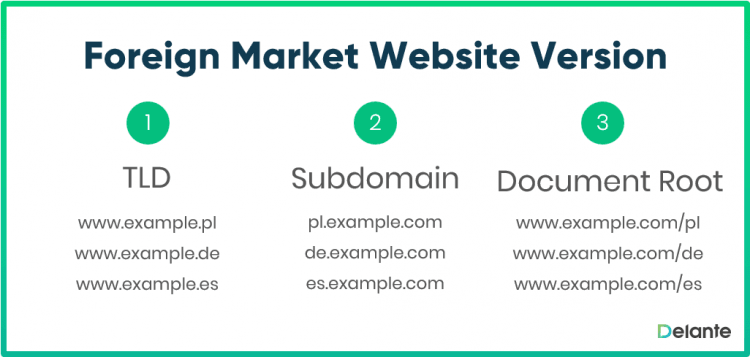Foreign Market Entry Success – With New Domains or Language Versions?

E-commerce is currently one of the fastest growing industries. As a result, more and more often business expansion leads straight to entering a series of foreign markets. In this article we’ll show a few battle-proven foreign market entry strategies, and discuss particular aspects worth paying attention to.
Websites (stores included) are undoubtedly a powerful tool for running your business online. That’s, however, true for simply retail, but also for all kinds of additional marketing activities. What, however, when a day comes, when business requires creating an offer for foreign customers? How to take on this challenge best, tech-wise?
To choose a foreign online market entry strategy well, several factors need to be taken into account:
- Type of your website
- Technologies your site employs – CMS, for that matter…
- Purpose of your website
- Main business goals and overall marketing strategy
- Number of language versions and markets where you’re present.
What to choose, then: a domain, a subdomain or pages?
There’s a number of ways to implement a website language version:
- TLD (top level domain) – internet domains are hierarchically structured, and that’s simply the highest one – for example https://delante.co/,
- Subdomain – as, for example https://de.delante.co/ (nonexistent, but who cares…),
- Primary Domain Document Root – for example https://delante.pl/de.
TLD
Top-level domain is usually assigned to a specific language and country. And that makes it much more difficult to get good rankings using a different language than the TLD-defined default language. For this reason, if you want to enter the foreign market with a dedicated TLD domain, it’s best to purchase one fitting the target country – for example there’s .de for Germany, .es for Spain, and so on. Due to very nature of this method, it will generate costs, the more of them, the more domains you will got, as each has to be purchased and then extended; availability issues may come up, too. On top of that, each of the TLDs you’ve got for each country, requires a different backlinks profile. Simply put, .com domains should have backlinks mainly from .com URLs – the rule is simple, but the implications are resource-consuming.
Another top-level domain relevant issue is user confidence. A market trend is observed, of consumers putting more trust in websites with coherent ccTLD (country-code top level domains) – generic TLDs such as .org, .info or .biz are – in customers’ eyes – lesser. Therefore, the ccTLDs have the potential to secure the Google TOP10, but one needs to mind the need for sensible SEO-resources allocation here. For instance, there’s no need for SEO if the site has the same or similar content for several regions using the same language.
Subdomains
As the owner of a specific main domain, we can create any number of subdomains within it we want. Each of those can view a different page content, therefore allowing language versions implementation. Mind, however, that, as were gTLD for human customers, subdomains are lesser for Google algorithms. For this reason, prior to setting up a SEO-successful subdomain, a trustworthy main domain going way back is necessary; if that is the case, a lot of “Google trust” can be passed on to all subdomains, which will in turn strengthen the rankings and trust put in the site. And while in theory all subdomain-based language versions work within one and the same main domain and therefore its power should – theoretically – be inherited, each subdomain will still require a separate, tailored international SEO process. Each of the subdomains ranks for different keywords, targeting different markets, needing different URLs to link to it. The ‘Subdomain Solution’ has the undoubted advantages of being cost-effective, as there’s no need to spend money on a brand new domain. At the same time, using subdomains allows you to create virtually any number of language versions you want; after creation, it only takes Google Search Console localization and language configuration and you’re all set! To maximize SEO efficiency, internal linking different subdomains and TLD should be in place.
Language version directories / subfolders
The simplest way to set up a new website language version is to create a relevant subfolder. However, under no circumstances confuse these with URL parameters that are objectively dubbed the worst of the methods available. Their opinion is due to the fact that URL parameters don’t support Google Search Console language and country configuration. On the other hand, a consoling advantage is that all the link juice is concentrated in a single domain and, a bit as in the case of subdomains, the link building process is therefore plain simple. Another reason for this solution is that creating and managing the language versions with subfolders is relatively simple. Compared to subdomains, however, subfolders-based solution has a significant disadvantage – different website language versions as main domain subfolders and interpreted by search engine crawls as a single whole, which in turn reduces the SEO process effects, by effectively preventing from clear separation of a part of the site. To sum up, this solution is recommended in cases of limited resources: financial and time.
Hreflang application & effective use
Regardless of the final choice of a strategy, one should always remember about the correct “hreflang” attribute application. Hreflang is a Google-recommended method of defining individual website language versions assigned to particular location and clarifying the relations between them.
A correct hreflang application brings one more benefit, too – it allows for a significant reduction, if not total erasure of the on-page internal content duplication, which is always a risk if there are several page versions in similar languages. Another duplicated-content risky scenario is having the same language version for several locations (e.g. if you target British and American market with the same products and the product sites differ only in shipping costs, currency, time, etc. – duplication remains therefore significant). Correctly implemented hreflangs provide the crawls with clear instructions as to the location of a specific language website version, which is likely to impact the SEO positively.
How to implement hreflang correctly?
In order to start using hreflang right, follow these 3 on-page steps:
- Insert the relevant line of HTML code on the page in the <head> section, for example: <link rel = “alternate” hreflang = “de-DE” href = “https://delante.co/de” />;
- Alter the HTML header, for example: Link: <https://delante.co/plik.pdf>; rel = “alternate”; hreflang = “en-PL”, <http://de.delante.co/plik.pdf>; rel = “alternate”; Hreflang = “de-DE”;
- In the sitemap file (sitemap) add link to the language versions.
- The value of the hreflang attribute specifies mainly the language, but can define too the region and the relevant page version that is to be displayed. These features allow to obtain the following combinations:
- the same language version regardless of the region – for example “de” will display the German version,
- region-depending language version – “en-GB” which means English language version for all United Kingdom traffic,
- “De-ES” will display content in German for users clicking from Spain.
The method that employs the HTML header is especially recommended for content published in a non-HTML format. One must not, however, forget about so-called return tags. If a Polish-to-English version switch is implemented, some way to inverse this operation should be implemented, too.
Detailed tips on how to properly use the hreflang attribute in a variety of contexts are in the Google Search Console Support page.
GSC and GA for effective analytics
If we are not certain if the hreflang attribute has been implemented correctly, a dedicated Google Search Console feature will tell us. Any errors resulting from the language versions implementation are highlighted in the “Search Traffic” section, the “International Targeting” tab. Two types of errors may occur:
- Missing return links
- Incorrect language codes
It is a good practice to implement in each language version links to all the others and to itself. For example, a Russian page with German and French variants should display links to the German, French and Russian versions.
Webmasters using Google Search Console can use Geographic Targeting feature to determine the website localization and the target country. Unless you have a ccTLD that’s always dedicated to a specific country, such as .pl for Poland or .de for Germany, it is possible to select any location. Despite this freedom to choose any country as a target, it’s not always recommended. Before applying any changes, bear in mind whether the content that’s currently on your website will prove useful to foreign users.
Configuring different language versions tracking looks slightly different depending on how were these versions implemented. An individual TLDs scenario is relatively straightforward – each of the foreign and home domains should in this case have an individual tracking code to collect the data separately. In the case of subdomains and subfolders, only one tracking code is used. The data thus gathered should then be subjected to appropriate filtering.
Summary
In order to launch different language website versions you don’t need to purchase separate domains, but it takes a lot more than just writing the content for each of the target countries… Depending on the strategy adopted, as well as technical and financial capabilities, foreign online market entry process can be carried out in several different ways. Despite this, whatever method one picks, making sure that the hreflang attribute implementation and the configuration of analytical tools are done right, are the evergreen and firm good practices. Doing this will allow you to get better search results rankings and will make the analysis of the results and data gathered more plain and the conclusions clear.



